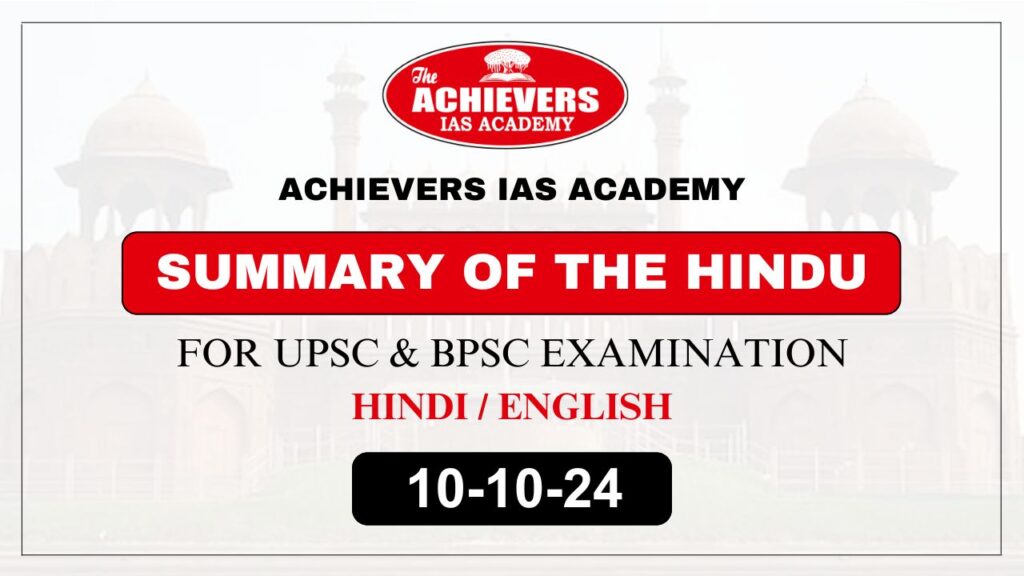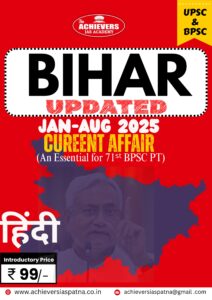
Edition: International Table of Contents
Page 01 Syllabus : Prelims Fact | Ratan Tata, a titan of Indian industry, takes his final bow |
Page 07 Syllabus : GS 3 : Indian Economy | RBI holds rate at 6.5%, shifts stance to ‘neutral’ |
Page 08 Syllabus : GS 3 : Internal Security | CCS clears deals for 31 MQ-9B drones and submarines |
Award In News | Nobel Prize in Physics |
Award In News | Nobel Prize in Physiology or Medicine |
Page 06 : Editorial Analysis: Syllabus : GS 2 : Indian Society – Urbanisation, their problems and their remedies. | Mental health in India’s material world |
Page 01 : Prelims Fact
Ratan Naval Tata, former chairman of the Tata Group and renowned industrialist, passed away at 86, leaving behind a legacy of business leadership and philanthropy.
- His visionary contributions transformed Tata into a global entity, inspiring generations through his humility and purpose.
About Ratan Tata:
- Ratan Tata led Tata Group from 1990 to 2012 and briefly returned as interim chairman in 2016.
- Under his leadership, Tata Group expanded globally with significant acquisitions such as Tetley, Jaguar Land Rover, and Corus Steel.
- He was known for reshaping the Tata Group into a global powerhouse while maintaining a focus on philanthropy.
- Post-retirement, Tata invested in multiple start-ups through RNT Associates.
- Philanthropy: He is known for championing causes like education, healthcare, and rural development through Tata Trusts
- He is recipient of India’s highest civilian honours, including the Padma Bhushan (2000) and Padma Vibhushan (2008)
- His influence extended beyond business, leaving an indelible mark on Indian industry and philanthropy.
Page 07 : GS 3 : Indian Economy
The Reserve Bank of India (RBI) has maintained its benchmark interest rate at 6.5% for the tenth consecutive time while shifting its stance to “neutral.”
- This change indicates a potential openness to rate cuts in response to economic conditions.The Monetary Policy Committee aims to align inflation with its target while supporting growth.
RBI Shift to Neutral Stance:
- Neutral stance means RBI is neither inclined to hike nor cut interest rates in the near term.
- This shift from “withdrawal of accommodation” indicates flexibility to adjust rates depending on economic conditions.
- It reflects a balanced approach, where inflation is controlled, but growth support is also considered.
- A neutral stance allows the RBI to respond swiftly to changing inflation and growth dynamics without pre-commitment to a particular policy direction.
Reasons for the Shift:
- Moderating inflation: Headline inflation has decreased from its heightened levels in the past two years, providing room for policy adjustment.
- Balanced macroeconomic outlook: Both inflation and growth are currently stable, allowing flexibility in monetary policy.
- Resilient domestic growth: Sustained momentum in private consumption and investment supports the focus on inflation.
- Uncertainty in inflation trends: External factors like adverse weather events and geopolitical tensions may lead to volatility in inflation, requiring a cautious policy stance.
Potential Implications:
- Possible rate cut: A neutral stance opens the door for an interest rate cut if inflation remains under control and growth is stable.
- Focus on inflation management: The RBI will continue to monitor inflation closely and may intervene if inflationary pressures resurface.
- Growth support: By shifting to neutral, the RBI signals it is prepared to stimulate growth if needed while keeping inflation within the target.
- Market stability: A neutral stance can provide reassurance to markets, balancing expectations on interest rates and reducing volatility.
Monetary Policy Committee (MPC)
- Formation: The Monetary Policy Committee (MPC) was established by the Reserve Bank of India (RBI) in 2016 under the Reserve Bank of India Act, 1934.
- Composition: The MPC consists of six members, including the RBI Governor as the chairman, three RBI officials, and three external members appointed by the government.
- Objective: Its primary objective is to maintain price stability while keeping in mind the objective of growth.
- Inflation Target: The MPC aims to achieve a flexible inflation target of 4% with a tolerance band of +/- 2%.
- Decision-Making: Decisions on monetary policy are made through majority votes, with the RBI Governor having a casting vote in case of a tie.
- Meetings: The committee meets at least six times a year to review economic conditions and adjust monetary policy as needed.
Page 08 : GS 3 : Internal Security
The Cabinet Committee on Security has approved the acquisition of 31 MQ-9B UAVs and the indigenous construction of two nuclear attack submarines (SSNs). This decision underscores India’s commitment to enhancing its defence capabilities across the three armed services.
MQ-9B High Altitude Long Endurance (HALE) Unmanned Aerial Vehicles (UAVs)
- Altitude: Operate at altitudes above 18,000 feet.
- Endurance: Capable of flying for over 24 hours, allowing continuous surveillance and data collection.
- Applications: Used for intelligence, surveillance, reconnaissance (ISR), and targeted strikes in military operations.
- Examples: The MQ-9B, also known as the Reaper, is a prominent HALE UAV.
- Features: Equipped with advanced sensors, cameras, and communication systems for real-time data transmission.
- Strategic Importance: Enhance situational awareness and operational capabilities without risking human life in combat zones.
Nuclear Attack Submarines (SSNs)
- Operational Role: They serve as a second-strike capability, ensuring a nation can retaliate after a nuclear attack.
- Indigenous Development: India has developed its SSBN fleet under the Advanced Technology Vessel (ATV) program, enhancing its nuclear triad.
- Current Fleet: The first operational SSBN, INS Arihant, was commissioned in 2016, followed by INS Arighaat in August 2023.
- Displacement: SSBNs typically displace around 6,000 to 7,000 tons, allowing for stealth and substantial weapon capacity.
- Range: Equipped with intercontinental ballistic missiles (ICBMs), they can strike targets over 5,000 kilometres away.
- Significance: SSBNs bolster India’s national security and strategic autonomy, deterring potential adversaries and ensuring regional stability.
Award In News : Nobel Prize in Physics
The 2024 Nobel Prize in Physics has been awarded by the Royal Swedish Academy of Sciences to John J. Hopfield and Geoffrey E. Hinton, two pioneers whose groundbreaking work laid the foundation for modern artificial neural networks (ANNs) and machine learning (ML).
- Their work has had profound implications for various fields, from physics to biology, finance, medicine and chat Artificial Intelligence (AI) apps, including OpenAI’s ChatGPT (Generative Pre-trained Transformer).
What is the Contribution of John Hopfield?
- Hopfield Network: John Hopfield, is best known for creating the Hopfield network, a type of recurrent neural network (RNN) that has been foundational in ANN and AI.
- Developed in the 1980s, the Hopfield network is designed to store simple binary patterns (0s and 1s) across a network of artificial nodes (artificial neurons).
- A key feature of the network is associative memory, which allows it to retrieve complete information from incomplete or distorted inputs (similar to how the human brain recalls memories when triggered by familiar sensations, like a scent).
- The Hopfield network, based on Hebbian learning (a concept in neuropsychology where repeated interactions between neurons strengthen their connections).
- By drawing parallels to atomic behavior, Hopfield used statistical physics to make the network perform pattern recognition and noise reduction by minimising energy states, a breakthrough in advancing neural networks and AI by mimicking biological brain functions.
- Impact: Hopfield’s model system has been used to solve computational tasks, complete patterns, and improve image processing.
What is the Contribution of Geoffrey Hinton?
- Restricted Boltzmann Machines (RBMs): Building on Hopfield’s work, in the 2000s, Hinton developed a learning algorithm for Restricted Boltzmann Machines (RBMs), which enabled deep learning by stacking multiple layers of neurons.
- The RBMs could learn from examples rather than explicit instructions. This was revolutionary because it allowed the machine to recognize new patterns based on similarities with previously learned data.
- The Boltzmann machine could recognize categories it had never encountered if they matched learned patterns.
- Applications: Hinton’s work has led to breakthroughs in numerous fields, from healthcare diagnostics to financial modeling and even AI technologies like chatbots.
What is Machine Learning?
- About: It is a branch of Artificial intelligence (AI) that uses data and algorithms to enable computers to learn from experience and improve their accuracy over time.
- Operating Mechanism:
- Decision Process: Algorithms predict or classify data based on input, which can be labelled or unlabeled.
- Error Function: This function evaluates the model’s predictions against known examples to assess accuracy.
- Model Optimization Process: The model iteratively adjusts its weights to improve its predictions until it reaches an acceptable level of accuracy.
- Machine Learning vs. Deep Learning vs. Neural Networks:
- Hierarchy: AI encompasses ML; ML encompasses deep learning; deep learning relies on neural networks.
- Deep Learning: A subset of machine learning that uses neural networks with many layers (deep neural networks) and can process unstructured data without needing labelled datasets.
- Neural Networks: A specific type of machine learning model structured in layers (input, hidden, output) that mimic how the human brain works.
- Complexity: As transition from AI to neural networks, the complexity and the specificity of tasks increase, with deep learning and neural networks being specialised tools within the broader AI framework.
Award In News : Nobel Prize in Physiology or Medicine
Recently, the 2024 Nobel Prize in Physiology or Medicine was awarded to Victor Ambros and Gary Ruvkun by the Nobel Assembly at Karolinska Institutet in Stockholm, Sweden.
- The scientists won the esteemed prize for the discovery of microRNA and its role in post-transcriptional gene regulation.
- Note:
- The 2023 Nobel Prize in Physiology or Medicine was awarded to Katalin Karikó and Drew Weissman for their work on messenger Ribonucleic Acid (mRNA).
- The 2024 Nobel Prize in Physics has been awarded to John J. Hopfield and Geoffrey E. Hinton, for modern artificial neural networks (ANNs) and machine learning (ML).
What Discovery of microRNA led to the Nobel Prize?
- Early Research:
- elegans Model: Ambros and Ruvkun studied the roundworm C. elegans to understand tissue development.
- Mutant Strains: They analyzed mutant strains lin-4 and lin-14 with abnormalities in their genetic programming.
- Ambros’ Research:
- Ambros found that lin-4 suppressed lin-14 activity but couldn’t determine how.
- He cloned lin-4 and discovered a short RNA molecule without protein-coding potential. It suggested the RNA molecule might inhibit lin-14.
- Ruvkun’s Research:
- He found that lin-4 didn’t block lin-14 mRNA production but regulated it later by inhibiting protein production. A short lin-4 sequence matched key complementary segments in lin-14 mRNA.
- Ambros and Ruvkun found that lin-4 microRNA attaches to lin-14 mRNA and blocks protein production.
- Significance:
- let-7 discovery: Ruvkun’s group later discovered let-7, a microRNA present throughout the animal kingdom.
- Current understanding: The microRNAs are abundant and play a crucial role in gene regulation across multicellular organisms.
Page : 06 Editorial Analysis
Context :
- India is grappling with a growing mental health crisis, exacerbated by rising societal pressures, consumerism, and a focus on material success.
- Despite economic progress, many face stress, depression, and anxiety, feeling disconnected from community and purpose.
- A shift towards collective well-being and stronger social connections is essential to address these issues.
Introduction
- Recent tragic cases of young professionals ending their lives due to work pressures have highlighted the growing mental health crisis in India.
- Despite career success, many are struggling with depression, anxiety, and a lack of purpose in their lives, revealing a deeper societal issue.
India’s Mental Health Crisis
- India is experiencing a surge in mental health disorders, with over 197 million people affected by conditions such as depression, anxiety, and substance abuse, according to The Lancet Psychiatry Commission.
- Economic growth has created opportunities but also intensified societal pressures, leading to greater stress and personal expectations.
- Mental well-being is often overlooked as India’s developmental aspirations rise, further fuelling the crisis.
The Role of Materialism and Consumerism
- Existential questions about life’s purpose and meaning are overshadowed by the pursuit of efficiency, productivity, and material wealth.
- Consumerism and material success have distanced people from self-reflection and deeper values, exacerbating mental health issues.
- Many individuals, particularly in urban areas, feel isolated and disconnected from their communities despite achieving material success.
Rising Stress and Anxiety
- The pressures of urban living, financial instability, and fierce competition are contributing to a mental health epidemic in India.
- Material wealth provides temporary comfort but fails to meet deeper emotional and psychological needs, leading to stress, social comparison, and feelings of inadequacy.
- People often chase material wealth for social validation, but this pursuit neglects the essential elements of a meaningful life — self-awareness, purpose, and meaningful relationships.
The Disconnect from Meaning and Community
- Political and economic priorities reinforce the belief that wealth and consumption equate to happiness, further entrenching the mental health crisis.
- Modern consumerism promotes personal consumption and weakens social bonds, isolating individuals and leaving them feeling purposeless.
Collective Action and Community as Solutions
- A shift from individual success to collective well-being is necessary to address the mental health crisis.
- Strong social connections, supportive communities, and meaningful work are critical to mental health.
- Examples from other countries, like Brazil’s community gardens, show how shared responsibilities and fostering a sense of belonging can strengthen communities and combat isolation.
Community-Oriented Living
- Community-oriented living, which promotes shared responsibility, collective purpose, and mutual support, offers a sustainable alternative to the isolation of consumer culture.
- In such environments, individuals experience fulfilment through shared experiences, human connection, and empathy, reducing stress and mental health issues.
Consumer Choice and Mental Health
- India’s expanding middle class often equates personal freedom with the ability to buy goods, prioritizing material wealth over deeper values such as equality and fraternity.
- This reduction of freedom to consumer choice fuels feelings of inadequacy and stress, as individuals struggle to meet rising standards of success.
Rethinking the Good Life
- Addressing India’s mental health crisis requires rethinking the materialistic notion of success and refocusing on mental, emotional, and social well-being.
- Community living, mindfulness programmes, social-emotional learning, and mental health awareness are essential to create a culture that values mental well-being.
- Social policies that reduce inequality and provide mental health support are crucial for addressing the crisis.
Conclusion
- A good life is not defined by material achievements but by how individuals relate to themselves, their communities, and their environment.
- Prioritising community, equity, and mental well-being can build a healthier society where people feel supported and valued.
- Addressing the root causes of the mental health crisis will lead to a more meaningful and fulfilling future for all.

